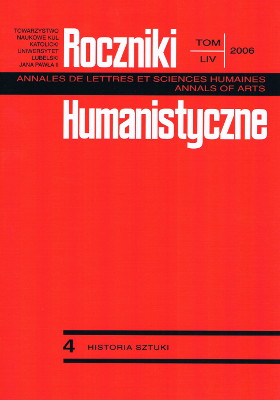Konfesja. Kilka uwag o znaczeniu terminu oraz jego używaniu i nadużywaniu w polskiej literaturze historycznoartystycznej
Abstrakt
A tendency has recently appeared in Polish art-historical literature, initiated most certainly by Szczęsny Dettloff, to treat the term confession in a very broad sense. One understand here all the altars that contain bigger relics, or almost complete bodies of saints. Now Ryszard Mączyński's book crowns this tendency, for it numbers several dozen “modern Polish confessions,” which most often have the form of an altar with relics laid in an ornamented coffin lifted up above a mensa.
This form of an “altar-confession” is decisively different from the description of confessio contained in Milanese Archbishop St. Charles Boromeo's Instructiones fabrica et supellectilis ecclesiasticae of 1577, which is commonly thought to be the most important regulation of the principles of Catholic sacred art in the period after the Trident Council. He stated that the confessio should have the form of a crypt under on altar, containing the relics of a saint. Now confessions whose shape correspond to this definition were encouraged by Boromeo himself (in S. Prassede's church in Rome, in the cathedral, and in S. Fedele's church in Milan), and the bishops under his influence (e.g. Cardinal Gabriele Paleotti in the cathedral in Bologna). The famoust confession erected during the Counterreformation was St. Peter's confession in the Vatican Basilica (Carlo Maderno, completed in 1616). The altar and the baldachin put up over this wide crypt were never described in the 17th century as integral elements of the confessio, but as autonomic structures, supplementing the ornamentation of the tomb of the first pope. In the Italian texts of the Counterreformation period we do not find any transposition of the term confessio on the altar in which the bigger relics are laid over the floor, in the mensa, or in the retable. This type of altars were not called confessions even in the Polish sources until the end of the 18th century. Most often they were simply described as tombs or saints' mausoleums. Therefore it seems that referring the term confession to them is obviously anachronic and can make difficult in the future to study the sources of the artistic ornamentation of the saints' cult in Polish Kingdom of the Counterreformation period.
The scope of the term confession, recently propagated by Mączyński, also decisively diverges from the definition of the term, as it is assumed in the most important West European artistic lexicons. We mean those lexicons that have the same scope of the term in relation to the Counterreformation epoch as it was assumed by Boromeo. We can do nothing but to adjust the Polish meaning of the confession to the standard accepted by scholars in other countries. If we allow ourselves to be free in acquiring universal artistic terms, we can be separated in the history of art from scientific discussion that is going on in other countries.
A tendency has recently appeared in Polish art-historical literature, initiated most certainly by Szczęsny Dettloff, to treat the term confession in a very broad sense. One understand here all the altars that contain bigger relics, or almost complete bodies of saints. Now Ryszard Mączyński's book crowns this tendency, for it numbers several dozen “modern Polish confessions,” which most often have the form of an altar with relics laid in an ornamented coffin lifted up above a mensa.
This form of an “altar-confession” is decisively different from the description of confessio contained in Milanese Archbishop St. Charles Boromeo's Instructiones fabrica et supellectilis ecclesiasticae of 1577, which is commonly thought to be the most important regulation of the principles of Catholic sacred art in the period after the Trident Council. He stated that the confessio should have the form of a crypt under on altar, containing the relics of a saint. Now confessions whose shape correspond to this definition were encouraged by Boromeo himself (in S. Prassede's church in Rome, in the cathedral, and in S. Fedele's church in Milan), and the bishops under his influence (e.g. Cardinal Gabriele Paleotti in the cathedral in Bologna). The famoust confession erected during the Counterreformation was St. Peter's confession in the Vatican Basilica (Carlo Maderno, completed in 1616). The altar and the baldachin put up over this wide crypt were never described in the 17th century as integral elements of the confessio, but as autonomic structures, supplementing the ornamentation of the tomb of the first pope. In the Italian texts of the Counterreformation period we do not find any transposition of the term confessio on the altar in which the bigger relics are laid over the floor, in the mensa, or in the retable. This type of altars were not called confessions even in the Polish sources until the end of the 18th century. Most often they were simply described as tombs or saints' mausoleums. Therefore it seems that referring the term confession to them is obviously anachronic and can make difficult in the future to study the sources of the artistic ornamentation of the saints' cult in Polish Kingdom of the Counterreformation period.
The scope of the term confession, recently propagated by Mączyński, also decisively diverges from the definition of the term, as it is assumed in the most important West European artistic lexicons. We mean those lexicons that have the same scope of the term in relation to the Counterreformation epoch as it was assumed by Boromeo. We can do nothing but to adjust the Polish meaning of the confession to the standard accepted by scholars in other countries. If we allow ourselves to be free in acquiring universal artistic terms, we can be separated in the history of art from scientific discussion that is going on in other countries.
Copyright (c) 2006 Roczniki Humanistyczne

Utwór dostępny jest na licencji Creative Commons Uznanie autorstwa – Użycie niekomercyjne – Bez utworów zależnych 4.0 Międzynarodowe.





